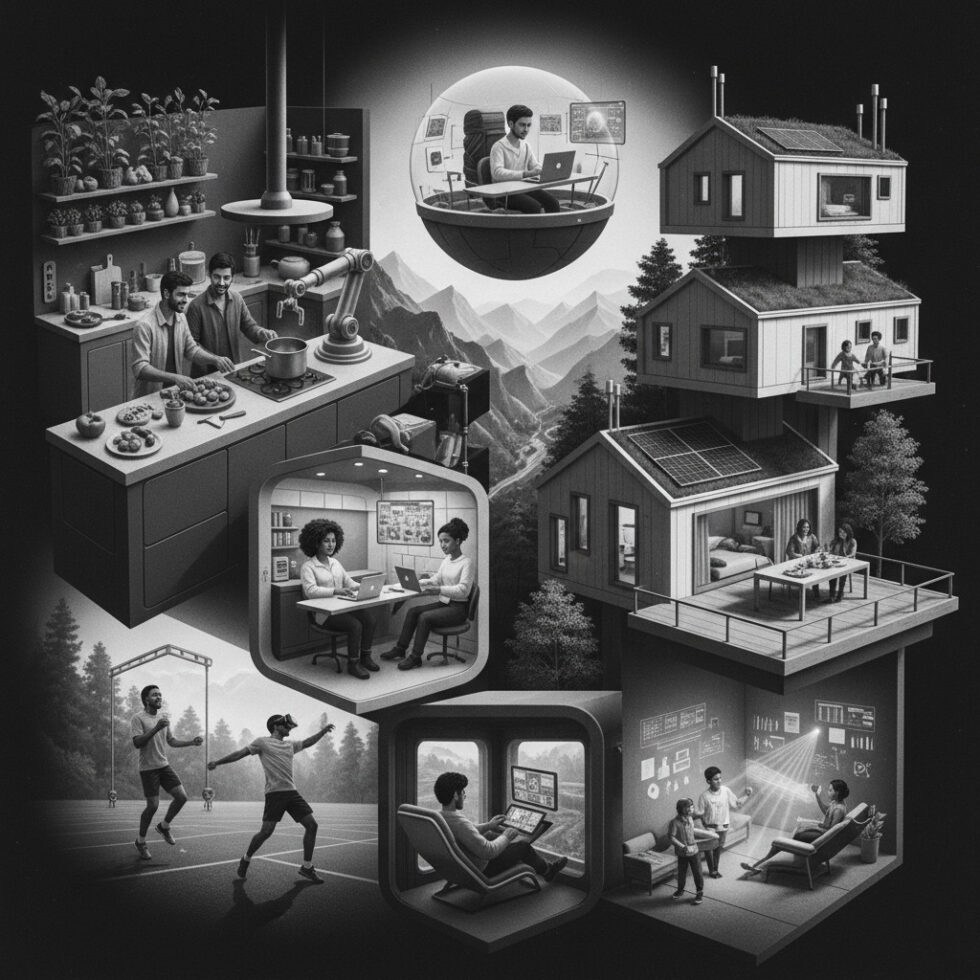
Why the Next Ten Years Will Redefine Everyday Life
The most interesting changes rarely arrive with a headline. They show up in your pantry, your calendar, your sneakers, and your sleep. In the coming decade, lifestyle trends will be driven by three simple pressures: your time, your health, and your local environment. Technology and science will keep pushing the frontier, but everyday choices will be shaped by things we can feel—the price of energy, the quality of air, the taste of dinner, and how rested we are on Monday.
This article surveys ten shifts already pulling on daily routines. None are fads. Each has a practical core, backed by real-world trials, public data, or market signals. Expect the details to evolve, but the direction of travel is clear. Think smaller, smarter, calmer, and closer to home.
1) Food Gets Personal, Planet‑Savvy, and Delicious
From one‑size‑fits‑all to “this works for me”
Food talk often gets loud and tribal. Over the next ten years, the volume will drop as nutrition becomes more individualized. The shift isn’t about a miracle diet. It’s about tighter feedback loops. Affordable blood glucose sensors, sleep trackers, and simple food journals help people notice what meals actually do for their energy, mood, and cravings. The big idea: eat what you test, not what you’re told.
Microbiome‑friendly habits go mainstream
Fermented foods—yogurt, kefir, kimchi, kombucha—will move from “interesting” to “ordinary.” Not because they are trendy, but because they often help people feel better within weeks. Expect a boom in countertop fermenting kits, starter cultures with clear instructions, and local workshops. Home fermentation reduces packaging, connects you to flavor, and keeps produce from the compost bin.
Sea greens and “small proteins” step forward
Plant‑forward eating will keep gaining ground, but the menu will diversify. Seaweed, mussels, oysters, and mycoprotein fit a pattern: nutrient‑dense, relatively low‑impact, and versatile. Seaweeds add umami and minerals; bivalves can be farmed with minimal inputs; mycoprotein is fiber‑rich and cooks like meat. You won’t have to become a zealot to enjoy them—think pasta with a seaweed‑garlic crumble or a mussel stew once a week.
Waste‑free cooking becomes a household sport
As food prices bounce and climate concerns sharpen, zero‑waste cooking will feel less like sacrifice and more like skill. You’ll see more “root‑to‑leaf” recipes, bone broths, and freezer‑friendly batch cooking. The winning move: a simple weekly ritual. Pick a “use‑it‑up” day, make a frittata, soup, or grain bowl from whatever’s left, and save money while clearing space for the next round of groceries.
- Keep a “first to eat” bin in the fridge to catch near‑term items.
- Prep a base grain or bean on Sundays to speed weeknight meals.
- Freeze herb stems and scraps for stock; label and date everything.
2) Work and Time: Fewer Meetings, Better Weeks
The four‑day week moves from pilot to policy
Trials across sectors suggest that shorter weeks can lift productivity and morale when teams protect focus and rewrite meeting habits. The next ten years won’t make a perfect four‑day schedule universal. But expect more organizations to offer 32‑to‑36‑hour options, especially where output is measurable. The individual playbook looks like this:
- Guard deep work: Two mornings a week without meetings.
- Clarify handoffs: Clear documentation so anyone can pick up the thread.
- Rehearse “no”: Decline recurring meetings that lack agendas.
Neighborhood “third places” for quiet focus
Hybrid work is settling into a rhythm: a couple of office days, a couple at home, and a day in a shared neighborhood space. Libraries, quiet cafés, and small coworking studios will fill the niche between the noisy house and the long commute. Expect memberships that bundle coffee, lockers, phone booths, and community events. The best ones will feel like a university reading room with better lighting.
Calendar dieting beats productivity hacks
The next big “hack” is subtraction. People are discovering that cutting 15% of recurring slots from their calendars creates 50% more energy. Try a quarterly purge. For each meeting: If this never existed, would we add it today? If the answer is no, cut it or shorten it. The metric to watch isn’t hours worked. It’s quality hours—the ones where you moved a real project forward.
3) Homes Designed for Comfort, Quiet, and Resilience
Comfort that holds up when the weather doesn’t
Weather is getting weirder, and homes are adjusting. Not with flashy gadgets, but with smart basics:
- Shade and airflow: Exterior shades, ceiling fans, and cross‑breezes reduce AC load.
- Cool sleeping: Breathable bedding and phase‑change mattress pads help during heat waves.
- Air quality: HEPA purifiers and habit tweaks—like shoes‑off and regular filter changes—make a bigger difference than most people guess.
Quiet tech, not more tech
The trend at home is calm. Fewer alerts. Fewer bright LEDs. Appliances that whisper, not sing. Expect products with “do not disturb” defaults and physical controls that work when the app doesn’t. The goal isn’t to own more devices; it’s to feel more human in your space.
Resilient by default
Small upgrades will become normal: a battery that rides through short outages, window films that block heat, backup water filters, and basic emergency kits tucked into closets. None of this requires a bunker mindset. It’s the same logic as carrying a spare tire—boring until you need it, then priceless.
4) “Longevity‑Lite”: Health Habits That Actually Stick
Strength training becomes a standard, not a niche
Muscle is not about aesthetics; it’s a health organ. Strength supports bone density, metabolic health, and balance. Expect basic strength work to become as common as walking. The format can be simple:
- Two or three sessions per week.
- Five movements: squat, hinge, push, pull, carry.
- Progress slowly; focus on form and consistency.
Sleep moves from “nice to have” to non‑negotiable
Everything is easier with better sleep: appetite control, mood, learning, and immune function. The next decade will treat sleep like we learned to treat handwashing. Standard routines will include dimming lights after dinner, capping caffeine early, keeping bedrooms cool, and respecting fixed bed and wake times. Wearables can help, but the principles are simple and free.
Micro‑checks beat annual resets
Instead of “new year, new me,” people will adopt weekly or monthly micro‑reviews: How did that lunch make me feel? Did I walk more on weeks when I biked errands? Which bedtime gives me the best morning? Small questions, honest answers, and a tweak. That’s how habits compound for years.
5) Slow Travel Returns, with Smarter Logistics
Travel for meaning, not mileage
The coming travel trend is not about collecting airport codes. It’s about trips that feel good during and after: fewer flights, longer stays, and deeper curiosity. Night trains will find a new audience in regions where routes are viable. Closer to home, “micro‑adventures” will shine: a Friday night train, a Saturday hike and campout, a Sunday café and home by dinner.
Pack lighter, experience more
Ultralight travel isn’t just for hikers. A small backpack reduces stress and opens choices: you can walk to the station, hop a local bus, or swap plans faster. The guiding question: What would I pack if I had to carry it all day?
Respect your future self
Choose itineraries that pass the Monday test. If you’ll need two days to recover, it wasn’t a break. The next decade’s travel goal is genuine restoration, not busy postcards.
6) The Circular Closet: Repair, Resale, and Material Literacy
Wardrobes built on stories, not stuffing
The smartest trend in clothing is owning fewer pieces you love and maintain. Resale and repair are normal now, but the next step is material literacy: understanding how fabrics age and how to care for them. Wool can be aired out; linen softens with wear; high‑quality cotton can be mended for years. You don’t need a degree, just a mindset: buy for the long run, care for what you own, and sell or swap what you don’t use.
How to start a circular routine
- Create a small repair kit: needles, threads, buttons, iron‑on patches.
- Learn one mend (e.g., darning socks) via a local class or a trusted video.
- Use a resale app or neighborhood swap once per season to rebalance your closet.
Performance where it matters
Expect more garments to quietly improve on function—better sun protection, quick‑dry fabrics, and durable water‑repellent finishes that avoid harsh chemicals. The north star is gear that works across settings: a jacket that can handle drizzle, a meeting, and a bike ride.
7) Social Life Grows Smaller, Deeper, and More Local
Crafts, clubs, and shared skill time
Many people crave in‑person flow after years of screens. Look for a rise in small clubs: fermentation nights, bread baking, park clean‑ups, birding walks, language tables, and neighborhood sports leagues. These gatherings are cheap, repeatable, and welcoming. They build friendships and skills without turning life into a performance.
Phone‑polite spaces
Venues will experiment with “phone light” norms: clear phone areas, signal‑quiet corners, and signage that invites presence without shaming. It’s not about bans. It’s about friction that helps you decide.
Intergenerational tables
Shared meals across ages will become a quiet superpower. Younger people get stories and tips; older people get fresh views and company. Expect community centers and libraries to host regular mixed‑age events—potlucks, board game nights, and skill swaps.
8) Mobility Shrinks: Small Electric, Big Freedom
Short trips, small vehicles
Most daily trips are under a few miles. That’s perfect for walking, biking, and small electric rides. Cargo bikes haul groceries and kids. Compact e‑scooters and e‑bikes flatten hills and heat. Side benefits include better mood, more daylight, and surprise conversations. As routes improve and parking stays tight, this “little locally” pattern will spread.
Designing a friction‑light commute
- Store your ride near the door to remove setup friction.
- Keep rain gear handy so weather isn’t a show‑stopper.
- Map a shaded summer route and a wind‑sheltered winter route.
Rent, don’t own, when you can
For occasional needs—like weekend cargo or visiting friends—shared cars, tool libraries, and rental vans will cover the gaps. The math favors access over ownership when usage is low.
9) The Subscription Diet: Getting Back to “Enough”
Membership minimalism
Households are waking up to a quiet drain: too many small monthly charges. The fix is a subscription diet. Twice a year, audit every auto‑pay. Keep what adds delight or removes friction; cut what’s “nice but not used.” Bundle with your household and friends where possible. A dozen cuts can free money for better food, a fitness class you love, or a weekend trip that actually restores you.
Community‑supported services
Borrowing a page from community‑supported agriculture, neighborhoods will support shared services: childcare swaps, meal trains for new parents or post‑surgery neighbors, tool sheds, and study buddy rosters. These models convert money pressure into human connection. They also build resilience: when a storm hits or power goes out, you already know who has what.
10) Everyday Climate Skills: Heat, Smoke, and Water
Practical skills for tougher weather
Adapting to heat waves and smoky days will feel normal soon. A few simple skills go a long way:
- Heat: Hydrate early, shade windows, use fans properly (they cool people, not rooms), and cool the body with water—wrists, neck, and face.
- Smoke: Check air quality apps, use HEPA purifiers, improve window seals, and wear a well‑fitting mask outdoors on bad days.
- Water: Keep a basic kit: a gravity filter, spare jugs, and a plan for boiling if needed.
Neighborhood response beats solo heroics
The best upgrades are community habits. Establish a heat check‑in buddy for older neighbors. Share spare air filters during smoke events. Pool resources for shade tarps and extension cords to cool common rooms. When the worst day comes, you’ll have practice working together.
11) Learning That Fits Busy Lives
Micro‑learning with real outcomes
Short courses and skill sprints will keep growing because they match modern schedules. The difference in the next decade is tighter integration with daily routines. Ten minutes of language over coffee. A weekend knife‑skills class instead of binge‑watching. The guiding principle: learn just enough to use it this week. Then repeat.
Certainty through doing
Many people are overwhelmed by advice. The cure is tiny projects with fast feedback. Grow herbs on a windowsill to learn about sun and water. Fix a bike flat to learn patience and hand skills. Cook one new recipe a week to learn timing and heat. Action clarifies, and confidence sticks.
12) Parenting in a Calmer Register
Analog play, outdoor time, and sane screens
Families will lean into low‑tech joys because they work: nature walks, playground circuits, library hauls, and kitchen messes. Screen time won’t vanish. It will be bounded by predictable windows and content choices that calm rather than spin up. Parents will share toolkits: timers, device baskets, and “upstairs lives” for phones overnight.
Mini‑adventures within two miles
Pick five local destinations reachable without a car. Rotate them weekly. The goal is not novelty. It’s the rhythm and stress relief of getting outside together. You’ll make memories without logistics headaches.
13) Aging Better by Living Together
Multigenerational homes and friendly streets
As populations age, more families will choose living arrangements that share time and reduce costs. Expect accessory dwelling units, flexible floor plans, and friendly zoning where available. On the street, benches, shade, and safe crossings help all ages. Small design choices return large dividends in independence and belonging.
Caring without burning out
Caregiving will touch many households. Respite care, adult day programs, and peer support groups will become essential. The skill to learn is asking for help early. The practice to adopt is scheduling your own recovery like an appointment you must keep.
14) Clean Air as a Daily Habit
Ventilation and filtration made simple
Indoor air matters more than most people realize. A clear routine helps:
- Open windows for a few minutes when outdoor air is good.
- Use bathroom and kitchen exhaust fans during and after use.
- Run portable HEPA purifiers in bedrooms and living spaces.
- Replace HVAC filters on a schedule; mark your calendar.
House rules that age well
Shoes off at the door, a mat for wet days, and a vacuum with a HEPA filter keep dust and allergens down. Indoor plants won’t replace filters, but they do support mental wellbeing and humidity. Simple beats fancy.
15) Money Basics with More Joy
The envelope comes back, digitally or not
Budgets stick when they feel like a game, not punishment. Envelope budgeting—assigning money to named buckets—will keep spreading because it creates clear trade‑offs. You see the impact of that subscription or dinner in real time. The key is to save for joy, not just emergencies. A “fun fund” prevents blowouts.
Buying for the long run
Whether it’s a pan, a pair of shoes, or a bike, the cheapest option is often the one you use for years. Learn to read reviews for durability, not just unboxing excitement. If you can, try before you buy—especially for shoes and packs where fit is everything.
16) The Quiet Comeback of Hobbies
Leisure that produces, not just consumes
Hobbies are how you practice patience and play with your hands. The next decade will be kind to making: woodworking, sewing, gardening, singing in small choirs, community theater, amateur astronomy, and chess nights. Hobbies give you a social life that isn’t tied to alcohol or nightlife. They also build a gentle resilience: when screens stutter, you still know what to do with your time.
How to choose a hobby you’ll keep
- Pick one with a low setup cost.
- Choose a weekly time slot and stick to it.
- Find a group or class; accountability is magic.
17) Everyday Environmentalism You Can Feel
From distant goals to local wins
Climate talk can be abstract. The lifestyle shift is practical and sensory. Grow herbs so your kitchen smells better. Ride a bike because you feel alive on arrival. Eat more plants because your lunch no longer makes you sleepy. The planet matters, but the immediate reward is what keeps the habit. This is how culture changes: millions of small decisions that make life better right now.
Anchor habits you won’t drop
Pick three environmental habits that feel easy: a reusable bottle, a bike errand once a week, and a vegetarian dinner twice a week. Keep those. Ignore the rest until these are ingrained. Momentum beats guilt.
18) Designing a Week That Feels Like Yours
A simple template for the decade ahead
Here’s a pattern many households will adopt and adapt:
- Monday: Plan the week in 15 minutes. Block two focus mornings.
- Tuesday: Strength session; simple dinner; early lights.
- Wednesday: Neighborhood social time—club, class, or walk.
- Thursday: Use‑it‑up cooking night; tidy fridge; prep grains.
- Friday: Micro‑adventure setup or restorative home night.
- Saturday: Outdoor time; hobby hour; long meal with friends or family.
- Sunday: Reset home, prep, and rest. No late‑night screens.
It’s not rigid; it’s a rhythm. When life gets chaotic, rhythms rescue you.
How to Start: A 30‑Day Lifestyle Sprint
One change per week
- Week 1: Audit your calendar and cut two recurring commitments. Guard one deep‑work block.
- Week 2: Add two strength sessions and a fixed bedtime/wake time. Aim for a cool bedroom and dim evenings.
- Week 3: Do a use‑it‑up cooking night and prep a grain or bean on Sunday. Try one fermented side.
- Week 4: Plan one car‑free errand and one micro‑adventure. Set up a small air‑quality routine with a purifier or filter check.
Take notes, notice how you feel, and keep what clearly helps. That is the whole trick.
What Not to Worry About
Perfection is the enemy
You don’t need perfect gear or a perfect plan. You need a small start and the courage to adjust. Your neighbor’s routine is not yours. Be curious. Keep the changes that make you feel better in your body and your home. Let the rest go.
The Next Decade, Up Close
Most of the coming lifestyle changes share a texture: fewer but better things, more neighborhood life, gentler schedules, and rooms that feel like sanctuaries. The treasure is in the daily loop—what you eat, how you move, where you focus, and who you see. The world will keep throwing curveballs. A calmer, more skillful routine is your bat.
Summary:
- Food will skew personal and practical, with fermentation, sea greens, and waste‑savvy cooking.
- Workweeks will trend shorter with cleaner calendars and neighborhood “third places.”
- Homes will prioritize quiet comfort, clean air, and small resilience upgrades.
- Health will center on sleep and simple strength training routines.
- Travel will slow down: fewer flights, longer stays, and micro‑adventures.
- Wardrobes will get circular: repair, resale, and material literacy.
- Community life will deepen through clubs, crafts, and intergenerational meals.
- Mobility will shrink: small electric rides and walking for short trips.
- Subscriptions will get trimmed; community‑supported services will grow.
- Everyday climate skills—heat, smoke, and water—will become normal knowledge.
- Learning will be bite‑sized and tied to immediate use; hobbies will flourish.
- Simple weekly rhythms will beat complex plans and help routines stick.





